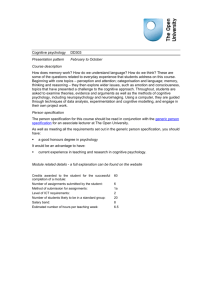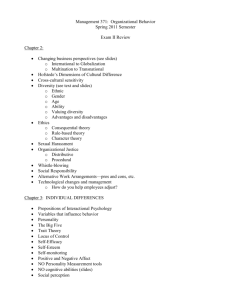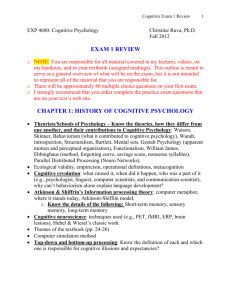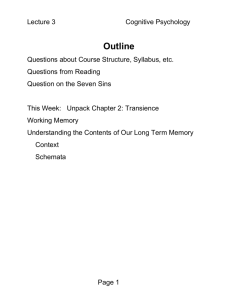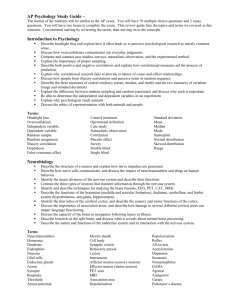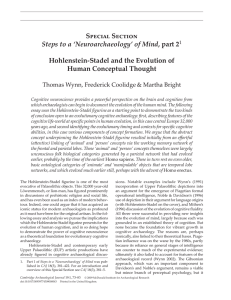Cognitive Psychology (PSY 366) - the Department of Psychology at
advertisement
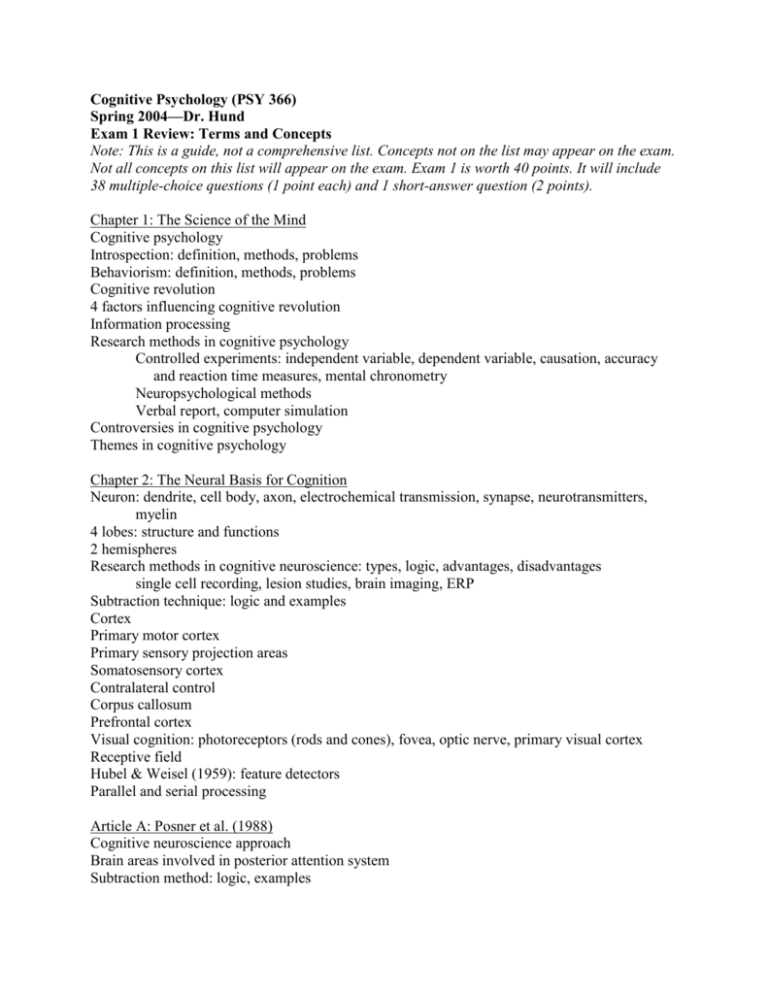
Cognitive Psychology (PSY 366) Spring 2004—Dr. Hund Exam 1 Review: Terms and Concepts Note: This is a guide, not a comprehensive list. Concepts not on the list may appear on the exam. Not all concepts on this list will appear on the exam. Exam 1 is worth 40 points. It will include 38 multiple-choice questions (1 point each) and 1 short-answer question (2 points). Chapter 1: The Science of the Mind Cognitive psychology Introspection: definition, methods, problems Behaviorism: definition, methods, problems Cognitive revolution 4 factors influencing cognitive revolution Information processing Research methods in cognitive psychology Controlled experiments: independent variable, dependent variable, causation, accuracy and reaction time measures, mental chronometry Neuropsychological methods Verbal report, computer simulation Controversies in cognitive psychology Themes in cognitive psychology Chapter 2: The Neural Basis for Cognition Neuron: dendrite, cell body, axon, electrochemical transmission, synapse, neurotransmitters, myelin 4 lobes: structure and functions 2 hemispheres Research methods in cognitive neuroscience: types, logic, advantages, disadvantages single cell recording, lesion studies, brain imaging, ERP Subtraction technique: logic and examples Cortex Primary motor cortex Primary sensory projection areas Somatosensory cortex Contralateral control Corpus callosum Prefrontal cortex Visual cognition: photoreceptors (rods and cones), fovea, optic nerve, primary visual cortex Receptive field Hubel & Weisel (1959): feature detectors Parallel and serial processing Article A: Posner et al. (1988) Cognitive neuroscience approach Brain areas involved in posterior attention system Subtraction method: logic, examples PSY 366 Exam 1 Review p. 2 Chapter 3: Recognizing Objects in the World Perception Binding problem Gestalt Psychology: definition, assumptions, principles of perception Figure-ground organization: definition, principles Theories of object recognition: definitions, advantages, disadvantages template matching feature analysis recognition by components Geon Visual search tasks and general findings Word-superiority effect Over-regularization errors Proofreading difficulty Prosopagnosia Face recognition Role of context on perception and object recognition Top-down processing/concept-driven processing Bottom-up processing/data-driven processing Interactive processing Efficiency v. accuracy of processing Article B: Treisman (1986) Two stages of visual processing Illusory conjunction Visual search: task, findings Parallel and serial search Role of attention in object perception Chapter 4: Paying Attention Selective attention Dichotic listening Shadowing Attended channel Cocktail party effect Broadbent’s filter model Treisman’s attenuated filter model Inattentional blindness Change blindness Posner’s spotlight theory: cueing paradigm, results, conclusions Treisman’s Feature Integration Theory Neural basis of visual attention Unilateral neglect syndrome Channel segregation v. crosstalk Divided attention PSY 366 Exam 1 Review p. 3 Dual task procedures Task-specific v. task-general resources Time-sharing Psychological refractory period Shiffrin & Schneider (1977) study: varied mapping condition, consistent mapping condition Automaticity Automatic v. controlled processes Stroop effect Practice Article C: Cowan (1993) Three aspects of memory system (Figure 1): definitions, examples Whispered reading and listening dual-task paradigm: task, findings, conclusions Decay and reactivation Role of attention in working memory Chapter 5: The Acquisition of Memories and the Working-Memory System *Focus on pp. 128-148 Encoding Storage Retrieval Atkinson & Shiffrin’s (1968) Modal Model Sensory registers: characteristics, capacity, duration Visual persistence Iconic memory Sperling (1960) Short term memory: characteristics, capacity, duration, retrieval Long term memory: characteristics, capacity, duration, retrieval Working memory: characteristics, capacity, duration Decay v. interference Serial position curve: recency effect, primacy effect Digit-span task Active span Central executive Visuospatial sketchpad Phonological loop Maintenance rehearsal Elaborative rehearsal Article D: Baddeley (1992) Three components of working memory model Relation between working memory and other cognitive abilities Dual-task paradigm: logic, task, findings, conclusions Compare and contrast Baddeley’s model and Cowan’s model


